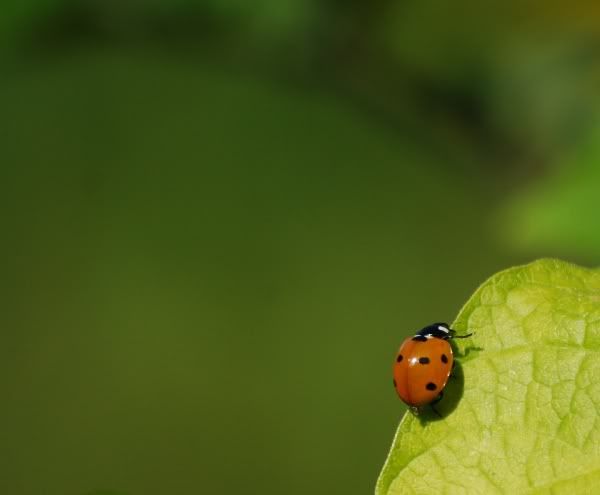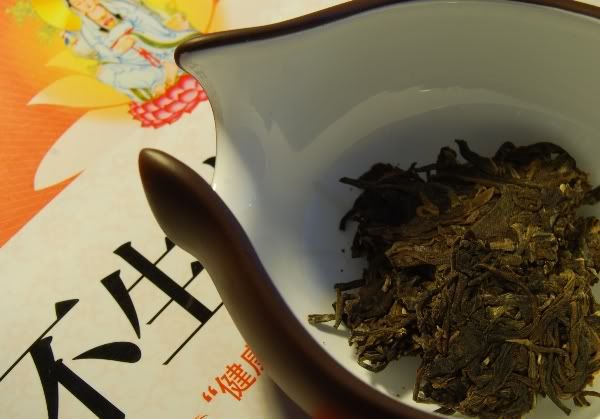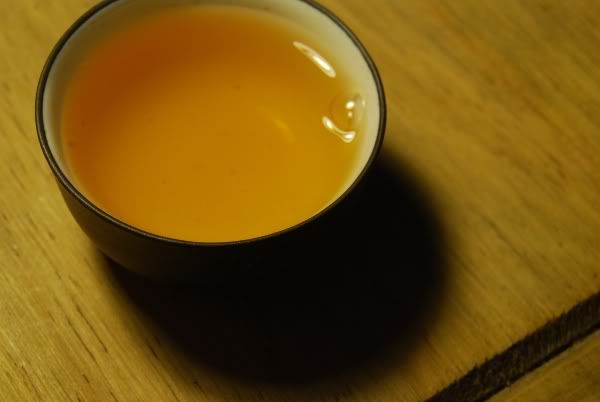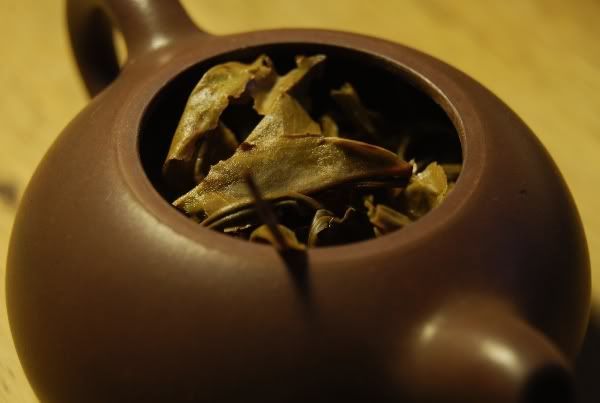I used to feel like I was drowning in a huge sea of pu'er. Lost in a vast world in which I could fathom little. It was a big world, and I was a small explorer.
Years later, and the world of pu'er hasn't got any smaller. I still get the feeling that I know very little - but I've stopped being concerned. I'm content to drink more, and explore more, and enjoy the journey.
Of the most notable changes is that, suddenly, the characteristics of various mountains are becoming a little more obvious to me. This is, I'm certain, simply because I have more data in each class with which my senses can perform inference. It's not a skill, or anything to get excessively excited about, but there is a definite progression from my previous state ("What on earth is the Menghai flavour that people mean when they say 'that Menghai flavour'?").
I'm under no illusions that I'm any other than a beginner (see standard disclaimer), but change has occurred. As gradual as the change in the cakes that line the shelves, it's a slow process - but something is happening.
Of the most notable changes is that, suddenly, the characteristics of various mountains are becoming a little more obvious to me. This is, I'm certain, simply because I have more data in each class with which my senses can perform inference. It's not a skill, or anything to get excessively excited about, but there is a definite progression from my previous state ("What on earth is the Menghai flavour that people mean when they say 'that Menghai flavour'?").
I'm under no illusions that I'm any other than a beginner (see standard disclaimer), but change has occurred. As gradual as the change in the cakes that line the shelves, it's a slow process - but something is happening.
This 2003 Lincang kindly provided by TA of the Tuochatea blog (please write more!) got me thinking about the identification single mountains.
TA bought this tea from his local seller in Prague, whom seemingly had this as a special order. A local vendor making and selling special orders is a thing to be treasured!
The reason that this tea got me thinking about the identification of single mountains is that it is so clearly Lincang: it's a great example of the teas from this region. Some time ago, I made a conscious decision to avoid drinking any old "filler" from pu'er vendors. Drinking these cakes, usually generic blends, left me nonplussed, and not much wiser with respect to pu'er. I drank a lot of rubbish.
After you've consumed twelve bland 6FTM productions in a row, you begin to wonder if there are better things to be drinking.
Since then, I've been restricting myself to buying samples of decent cakes, and sharing them with tea-chums (the majority of whom come from conversations springing out of writing the Half-Dipper, or on other Internet sites). This seems to have helped. They give your senses something to get stuck into, something to compare other teas with. It's not a conscious process, being "body learning" (or Zen learning), but it seems to have been accelerated since I started enjoying better pu'er.
Not stupidly expensive pu'er, I hasten to add: I count regular Dayi and Xiaguan as "better pu'er", as well as custom-made numbers such as this 2003 Lincang from TA, and everything in between. I've just learned to avoid the obvious howlers.
The reason that this tea got me thinking about the identification of single mountains is that it is so clearly Lincang: it's a great example of the teas from this region. Some time ago, I made a conscious decision to avoid drinking any old "filler" from pu'er vendors. Drinking these cakes, usually generic blends, left me nonplussed, and not much wiser with respect to pu'er. I drank a lot of rubbish.
After you've consumed twelve bland 6FTM productions in a row, you begin to wonder if there are better things to be drinking.
Since then, I've been restricting myself to buying samples of decent cakes, and sharing them with tea-chums (the majority of whom come from conversations springing out of writing the Half-Dipper, or on other Internet sites). This seems to have helped. They give your senses something to get stuck into, something to compare other teas with. It's not a conscious process, being "body learning" (or Zen learning), but it seems to have been accelerated since I started enjoying better pu'er.
Not stupidly expensive pu'er, I hasten to add: I count regular Dayi and Xiaguan as "better pu'er", as well as custom-made numbers such as this 2003 Lincang from TA, and everything in between. I've just learned to avoid the obvious howlers.
Hunt out some good leaves from good places. Most on-line vendors have large numbers of samples - and, happily, they often only stock samples of cakes that aren't completely rubbish.
I try to limit my tea intake by avoiding crazy excesses, and so this means I only have a limited capacity: I don't want to waste that capacity drinking flat teas. Capacity to drink tea is a treasured resource!
I try to limit my tea intake by avoiding crazy excesses, and so this means I only have a limited capacity: I don't want to waste that capacity drinking flat teas. Capacity to drink tea is a treasured resource!
So, even though the world of pu'er remains huge, and largely undented by my excursions, my attitude to it changed a long time ago. I'm no longer lost and scrabbling for my bearings, trying hard to work out this and that, but I'm gleefully sailing with the winds, without rudder or map.
Tea sessions are great fun. I remain bright-eyed.
Tea sessions are great fun. I remain bright-eyed.






I'm seeing my own future with Pu-erh tea as I read this. And I like what I see but I feel warned about drinking tea that isn't better stuff like single mountain. So far I've preferred mini tuo cha because it is convenient with good portion control. But I just might have to graduate from it fairly soon to being mindful of the pedigree of the tea. And I have to agree what I can control of that is watching what mountain it's from. --Spirituality of Tea
ReplyDeleteTo the extent that there are consistent differences in the cup between different Pu'er mountains, I wonder about the explanatory power of geography (soil, climate, etc.), genome, agriculture, and manufacture.
ReplyDeleteThis may seem an abstract question with little relationship to the practical enjoyment of tea, but consider this: China is changing rapidly, and Yunnan's no exception. So, of the four factors I've cited, why should we expect that ten years from now any but for geography will have remained the same? And one possible outcome would be for the manufacture, agriculture, and genome (except for the genuine old trees) to converge to a uniform set of, uh, best practices. How much would the mountains differ then?
Let's see if I can make some sense of Lewis' question.
ReplyDeleteClimate varies within regions (microclimate differences with elevation and latitude), but can be adequately described for that region by comparison of inter-seasonal variation (namely, Western Pacific ENSO phases and ICTZ shift for SE Asia). Therefore, we can say something about the comparative quality of teas harvested within certain valleys and the state of drought and temperature extremes, by season.
Microclimate may define a subregion, but soil quality will define a mountain.
Camellia plant gene *expression* can be said to be relatively plastic (adapting to place and culture) for trees less than say, 20 years old, when the root mass and adherent microbial community (rhizoculture) is maturing and altering the local soil profile with respect to micronutrients. At some point, the soils, the root zone and the microbial community stabilize. A subset of expression within the tea plant remains 'inducible' (climate extreme and pathogen-dependent responses for instance), but the chemical character of the plants tends to be relatively constant.
Culture can and does change gene expression, usually by application timing of fertilizers, cropping stress, and woody mass pruning stress.
But the fact is, for a given microclimate and soil type, stable and mature trees harvested with methods that have been in practice a LONG time tend to be reasonably predictable in leaf chemical characteristics that develop with processing.
The trick to continuity? That's the secret behind pu'erh recipes. The master will alter processing factors, and add aged leaves from the same mountain or from nearby locations, to achieve a testable aroma and flavor combination that is relatively close for consecutive production years of particular recipe.
The rub comes in variability in consumer demand for particular recipes and for you, the consumer, variation in market availability of recipe production runs.
The beauty of pu'erh? It's exceptional tendency to store well and improve with age and the reasonably robust regional production of pu.
You balance price/availability and guesstimate of acquired characteristics upon aging, and you salt away supplies as you are able - based upon experience, budget and storage space.
Experience is not so much learning a single mountain, but educating yourself on the exceptional range of product characteristics and quality and matching it against evolving preferences. That's takes time, palate development, and skill in analyzing, sorting and testing perceptions against notes and remembered result.
Pretty good question, worth an attempt at a reply.
I too feel somewhat lost midway upon the journey into the mysteries of pu'erh; I find myself within a "dark forest", and there seems to be no straightforward pathway - but I guess the best thing is to just keep tasting and enjoy the wonder that is pu'erh. Luckily, the Half-Dipper has its own poet to guide us to wisdom.
ReplyDeleteI recall when I was young the world was not so small.
ReplyDeleteThanks for the fascinating comment, Anonymous! For one thing, you've said something plausible and new to me about what distinguishes old trees from the rest. At the risk of being a pest, I would love to see a bibliography on what influences gene expression in tea plants.
ReplyDeleteRegarding Pu'er recipes, it's my impression that they represent an ever-decreasing segment of the market, for good or ill.
Hi! Insightful article Hobbes.
ReplyDeleteAre there any good sources for reading about the different mountains and what they offer? I'd like to have a list of pu-erh mountain names, so I could start tracing my pu-erhs back to their sources. I have to admit that I understand very little about pu-erh labeling besides city/province names. Unless it's really obvious like "Bulang Mountain," it's pretty much over my head.
Thoughts? Keep up the great writing.
Hi all! Back from France, apologies for the delay.
ReplyDeleteDear Jason,
Mini-tuocha would suffice if pushed, for sure, because they're going to be better than your average tea from a teashop! However, they usually lack the character and flavour of "real" pu'er, and you might find something you like in the pu'er world beyond mini-tuocha. There are always samples on offer from most venders, if you'd rather not commit to a large quantity, such as a full 357g bing. Let us know how you get on!
Dear Lewis and Anonymous,
Very true. I get the impression from my oenophile friends and relatives that your statements about long-term terriore hold for wine-growing, too. Local changes in soil handling can affect the tea, but the terriore is a long-term effect, often defined by soil, geology, and climate.
Dear Terje,
I wouldn't like to be anyone's guide - surely that would be the blind leading the blind! I appreciate your kind words, though. :)
Dear Mike,
You know, there's not a huge amount on offer, regarding reading matter for the mountains. A list of names can be had at "wikicha", which is a good wikipedia-style resource run by various kindly souls from the on-line Western tea world. Pu-erh.net is also good, but it's not been updated in a while.
Apart from that, I remember a good series of articles from MarshalN's Xanga on his opinions after drinking several single-mountain maocha, and blogs in general can be nice ways to learn about the context of different mountains, if not their precise terriore.
Toodlepip all,
Hobbes